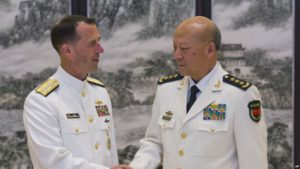Special to WorldTribune.com
 By Donald Kirk
By Donald Kirk
WASHINGTON — The Chinese remain the great enigma when it comes to figuring out whether they’re friend or foe, honorable adversaries or dangerous rivals for power and influence from the Korean peninsula to the South China Sea and beyond.
Nobody believes they’re doing much to discourage North Korea’s nuclear ambitions, but then again, nobody thinks they’re encouraging the North Koreans either. When they express their displeasure to the North Koreans over the latest nuclear test, the tone appears sincere and credible – just not too effective.
The problem may be that Chinese leaders themselves are uncertain where they are going, how much power they can afford to wield and how willing are they to risk a confrontation that might turn bloody. Unforeseen dangers lurk everywhere from the waters off Korea to the Japanese-held Senkakus, Diaoyu in Chinese, in the East China Sea to the flashpoints of the Spratly Islands and the Scarborough shoal in the South China Sea.

Probably no American is more sensitive to the Chinese puzzle, what to make of it and how to deal with it, than Adm. John Richardson, whose title of “chief of naval operations” means he commands the entire U.S. Navy. He says he’s met his Chinese counterpart, the commander of the Chinese navy, had a friendly conversation and believes the personal relationship: is vital to making sure U.S. ships can challenge China’s claim to the entire South China Sea without anyone firing a shot.
“We will continue to have access to the South China Sea,” he says, while “minimizing uncertainty” and “the risk of miscalculation.”
For now U.S. warships come and go across the South China Sea without coming to blows with the Chinese, but the future is highly uncertain.
What are the Americans to make of China and Russia staging war games together this week in those disputed waters while the Americans remain on the sidelines, observing what’s going on without getting in the way? Might the Americans and Chinese cooperate some day in similar exercises?
For now Richardson warns against “any regional security architecture that excludes China.” Clearly China “is this tremendous growing nation,” he observes. “Part of that global move is to the sea. Future architecture is going to have to include China.”
Just as the Americans and Chinese strive to avoid an open clash in the South China Sea, so they have to exercise the same extreme caution in considering what to do about North Korea. U.S. warships are not encountering the Chinese while staging war games with the South Koreans off the Korean east coast, but they’re not going deep in the Yellow Sea between China and the west coast of South Korea. Although the Chinese do not claim the Yellow Sea, they respond with extreme sensitivity to a strong U.S. naval presence in those waters.
In Northeast Asia, as in Southeast Asia, the U.S. and China are at historic odds regardless of their professed agreement on the need for North Korea to give up its nuclear program. The Chinese respond with alarm to moves by the U.S. to strengthen defenses against what’s seen as a rising chances that North Korea’s leader Kim Jong-Un may be willing risk a second Korean War while building up an arsenal of missiles and nuclear warheads.
The Chinese seem far more alarmed by the prospect of the U.S. deploying missiles capable of shooting down warheads in flight 100 miles above the earth than by the nightmare of North Korea firing missiles at targets in South Korea and Japan.
Probably the next U.S. president will need to focus on northeast Asia, North Korea in particular, with an intensity that transcends the “strategic patience” of the outgoing administration of President Barack Obama.
“He or she will have to use all the tools of American policy-making,” says Mark Fitzpatrick, a former senior U.S. diplomat with expertise in arms control, now director of the Washington office of the International Institute for Strategic Studies. The U.S. and China are sure to be at odds, however, on North Korean calls for a “peace treaty” in place of the armistice that ended the Korean War in 1953.
While refusing to give up its nuclear program, North Korea demands the U.S. pull its 28,500 troops from South Korea and break off the U.S.-Korean alliance. China blames the nuclear standoff on the Korean peninsula on U.S. refusal to consider a treaty unless North Korea gives up its nukes. China has paid lip service to ever tougher sanctions imposed on North Korea by the UN Security Council but is obviously not really enforcing them.
The nuclear issue adds a dimension to differences between the U.S. and China on North Korea, and by extension on Northeast Asia, that are likely to be far deeper than in the South China Sea. The U.S. “pivot” to Asia applied originally to concerns about the South China Sea and the Senkaku Islands, held by Japan in the East China Sea but claimed by China. As the North Korean nuclear and missile tests indicate, however, strategic and security concerns are inextricably linked by geography and by competing national interests.
In the meantime, as North Korea persists in testing missiles, Adm. Richardson propounds “the idea of doing everything you can to prevent being hit by one of those weapons.” That’s a goal that may eventually prove more difficult than avoiding a collision between U.S. and Chinese warships while nukes and missiles rank as Kim Jong-Un’s proudest achievement.
